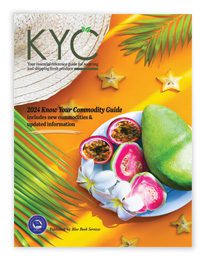Acai Berry Market Summary


Image: Alexander Ruiz Acevedo/Shutterstock.com
Acai Berry Market Overview
Açaí is the fruit of the palm tree Euterpe oleraceae. Açaí palms are indigenous to the Amazon River area in South America. The palms have been a staple in the Amazon for centuries, valuable for subsistence production, traditional medicine, and regional commerce. The tree has many uses, from building and weaving of stalk material to its highly prized palm hearts and berries.
The fruit is smaller than a grape; it is round and purplish, with the seed accounting for more than three-quarters of its size. Berries can be eaten fresh or added to smoothies, ice cream, yogurt, juice, wine, and liqueurs. Açaí has steadily grown in popularity due to its classification as a superfood.
Types & Varieties of Acai Berries
As açaí has only recently entered the U.S. market, there is still uncertainty regarding species and types. According to current research, there are two primary types: purple açaí, also called black açaí, the most well-known variety; and green açaí, which has fruit that ripens to a shiny dark greenish color.
There is ongoing research in Brazil into the development of optimal varieties. Among them is the BRS-Para Dwarf, which produces a shorter tree and matures earlier than other types.
The Cultivation of Acai Berries
Açaí palms grow best in tropical environments with ample sunlight and, surprisingly, prone to flooding. The trees grow in stalks, reaching heights of 100 feet. The palm grows a new stem every year from the root clump. Due to the difficulty of climbing the tall trees, palms are pruned often. In addition, açaí fruit grows well in groves, or açaízais, and are a key species in sustainable Amazonian agroforestry.
An açaí palm will bear fruit in its fourth or fifth year, in clusters high upon the palm, in bunches of 500 to 800 berries. A ripe açaí berry will be identified primarily by color: once they are a deep purple or near-black. Trees can produce berries all year but typically have highest volume in the dry season, between July and December.
In the Amazon, berries are harvested by climbing the tree and cutting the branch with a pruner. While trees can be climbed barefoot, in Southern Brazil metal climbing hooks, straps, and climbing harnesses are also used.
Açaí can be harvested fresh but must be processed or eaten within 24 hours. As such, the berries are rarely shipped, but immediately soaked in water, squeezed, and strained to create a concentrate, then frozen for distribution. Producers also process the berries into other value-added goods.
Pests & Diseases Affecting Acai Berries
Weevils feed on flowers and can prevent fruiting. The palm aphid can lead to abnormally shaped fruit, premature drop, and/or a sticky honeydew residue on fruit or leaves.
As açaí is not currently in significant commercial production in the United States, information on diseases is unavailable. There is no U.S. grade information for açaí at this time.
References: Palm & Cycad Societies of Australia, Rainforest Alliance, Universidade Federal de Santa Catarina, University of Illinois Extension.


